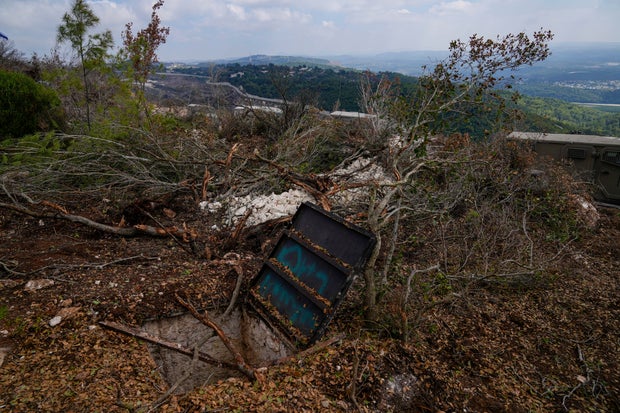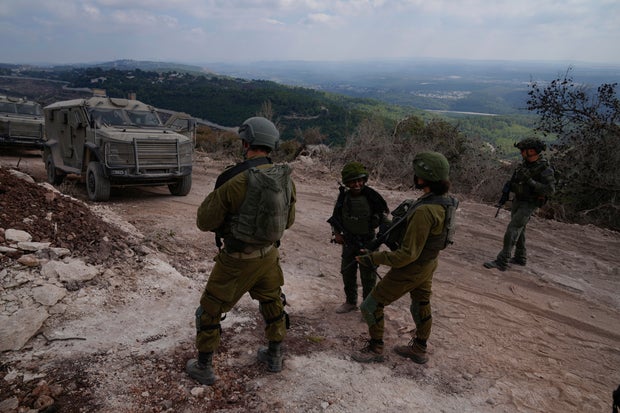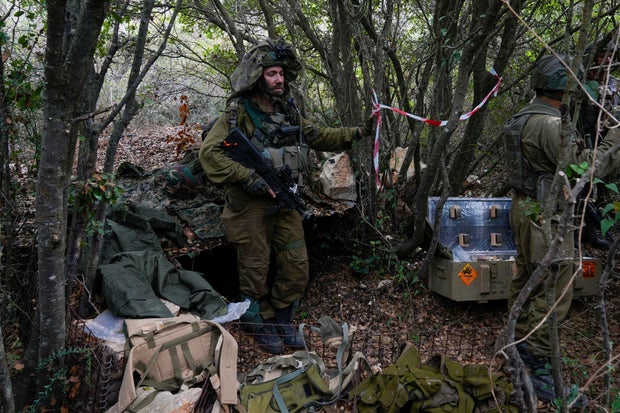Israeli forces have spent much of the past year destroying the vast underground network in Gaza. They are now focusing on dismantling tunnels and other hideouts belonging to Hezbollah militants in southern Lebanon.
Scarred by the deadly Hamas attack on Israel last year that sparked the war in gazaIsrael says it intends to avoid a similar incursion across its northern border.
The Israeli military has scoured the dense bush of southern Lebanon for the past two weeks, uncovering what it says are Hezbollah's deep strike capabilities, highlighted by a system of tunnels equipped with weapons caches and rocket launchers that Israel says , represent a direct threat to nearby communities. .
Sam McNeil/AP
Israel's war against the Iran-backed militant group extends deep into Lebanon, and its airstrikes in recent weeks have killed more than 1,700 people, about a quarter of whom were women and children, according to authorities. local health services. But his land campaign It has focused on a narrow strip of land right along the border, where Hezbollah has had a long-standing presence.
Hezbollah has deep ties to southern Lebanon
Hezbollah, which has called for the destruction of Israel, is the largest paramilitary force in the Arab world. It began firing rockets at Israel a day after Hamas' attack from Gaza on October 7, 2023. After nearly a year of back-and-forth fighting with Hezbollah, Israel launched its ground invasion of southern Lebanon on October 1 and has since sent thousands of troops to the rugged terrain.
Even as it continues to build up its forces, Israel says its invasion consists of “limited, localized and targeted ground incursions” aimed at destroying Hezbollah's infrastructure so that tens of thousands of displaced Israelis can return to their homes. The fighting has also uprooted more than a million Lebanese in the last month.
Sam McNeil/AP
Many residents of southern Lebanon support the group and benefit from its social reach. Although most fled the area months ago, they generally see heavily armed Hezbollah as their defender, especially since the US-backed Lebanese army does not have adequate weapons to protect them from any Israeli incursion.
That broad support has allowed Hezbollah to establish “a military infrastructure of its own” within the villages, said Eva J. Koulouriotis, a political analyst specializing in the Middle East and Islamic militant groups. The Israeli military says it has found weapons inside houses and buildings in villages.
Hezbollah built a network of tunnels in multiple areas of Lebanon
Since Israel's air power far exceeds Hezbollah's defenses, the militant group has turned to underground tunnels as a way to evade Israeli drones and aircraft. Experts say Hezbollah's tunnels are not limited to the south.
“It's a land of tunnels,” said Tal Beeri, who studies Hezbollah as research director at the Alma Research and Education Center, a think tank focused on northern Israel's security.
Koulouriotis said the tunnels extend beneath the southern suburbs of Beirut, where Hezbollah's command and management is located and where it maintains an arsenal of strategic missiles. He said the group also maintains tunnels along the border with Syria, which it uses to smuggle weapons and other supplies from Iran to Lebanon.
Southern Lebanon is where Hezbollah maintains tunnels to store missiles and from where it can launch them, Koulouriotis said. Some of the more than 50 Israelis killed by Hezbollah over the past year were hit by anti-tank missiles.
Sam McNeil/AP
Unlike the tunnels dug by Hamas in Gaza's sandy coastal terrain, Hezbollah's tunnels in southern Lebanon were dug into solid rock, a feat that likely required time, money, machinery and expertise.
An Israeli military official said that using previous intelligence, Israel had found “hundreds and hundreds and hundreds” of underground positions, many of which could house about ten fighters and were stocked with rations. The official, who spoke on condition of anonymity because of military rules, said troops were blowing up the tunnels or using cement to make them unusable.
The group used tunnels during the month-long war between Israel and Hezbollah in 2006, but the network has expanded since then, even as a United Nations ceasefire resolution forced Lebanese and U.N. forces to keep Hezbollah fighters out of the south.
In mid-August, Hezbollah released a video showing what appeared to be a cavernous underground tunnel large enough for trucks loaded with missiles to pass through. Hezbollah operatives were also seen riding motorcycles inside the illuminated tunnel, named Imad-4 after the group's late military commander, Imad Mughniyeh, who died in Syria in 2008 in an explosion blamed on Israel.
Hezbollah tunnels could be hindering Israel's mission
Israeli troops are advancing through southern Lebanon using tanks and engineering equipment, and air and ground forces have struck thousands of targets in the area since the invasion began.
The military recently said it found a cross-border tunnel that extended only a few meters into Israel but had no opening. Israel also exposed a tunnel shaft that was located about 100 meters (yards) from a UN peacekeepers ' put up, although it was unclear what the precise purpose of that tunnel was.
Israel says the tunnels are stocked with supplies and weapons and are equipped with lighting, ventilation and sometimes plumbing, indicating they could be used for extended stays. He says he has arrested several Hezbollah fighters hiding inside, including three on Tuesday who were reportedly found armed. The Israeli military official said many Hezbollah fighters appear to have withdrawn from the area.
Sam McNeil/AP
Lebanese military expert Naji Malaeb, a retired brigade normal in the Lebanese army, said he assessed that Hezbollah's tunnels were preventing Israel from making significant progress. He compared that achievement to the war in Gaza, where Hamas has used its tunnels to harass Israeli forces and organize insurgency-style attacks.
Israeli authorities insist that the mission in Lebanon is succeeding. They say Israeli forces have killed hundreds of Hezbollah fighters since the ground operation in Lebanon began, although at least 15 Israeli soldiers have been killed during that time.
Israel has encountered Hezbollah's tunnels before. In 2018, Israel launched an operation to destroy what were said to be attack tunnels crossing into Israeli territory. Beeri said six tunnels were discovered, including one 1 kilometer (1,000 yards) long and 80 meters (87 yards) deep, which crosses about 50 meters (yards) into Israel.
Israel believes Hezbollah was planning an October 7-style invasion
For Israel, the tunnels are evidence that Hezbollah planned what Israel says would be a bloody offensive against northern communities.
“Hezbollah has openly stated that it plans to carry out its own massacre on October 7 on Israel's northern border, on an even larger scale,” said Israeli military spokesman Rear. Admiral Daniel Hagari said the day troops entered Lebanon.
Israel has not released evidence that such an attack was imminent, but has expressed concern that one could be launched once residents return.
Hezbollah leader Hassan Nasrallahwho was killed by Israel last month while in an underground bunker, had signaled in speeches that Hezbollah could launch an attack on northern Israel.
In May 2023, just months before the Hamas attack, Hezbollah staged a simulated incursion into northern Israel with rifle-wielding militants on motorcycles bursting through a simulated border fence adorned with Israeli flags.
At times, Hezbollah officials have formulated calls for an attack on Israel as a defensive measure that would be taken in times of war.



